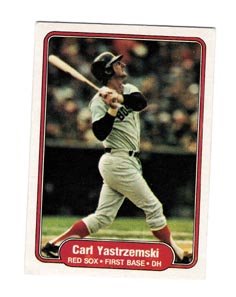In the summer of 1989, political scientist Francis Fukuyama published an essay in The National Interest titled "The End of History?" Fukuyama argued that Western liberal democracy marked the end of humanity's social evolution and that, contrary to Marx, democracy would be the prevailing style of government going forward.
If we replace "Western liberal democracy" with "nostalgia," this thesis could also accurately describe the approach and mind-set of Topps in 1989. Nineteen eighty-nine saw Topps's re-introduction of the Bowman brand, complete with oversized cards, a la 1953. While oversized cards were used for only the inaugural set, the design choices put forth in 1989 Bowman catered to those nostalgic adult collectors, and set the company on the path to today's hobby landscape: obsessed with retro designs, with fewer and fewer original designs and new ideas.
I could write an entire essay on the design decisions (or lack thereof) of Bowman, but let's talk about Topps Archives instead. When the brand started in 1991, it was strictly as a reprint of the 1953 set, with a few cards tacked on at the end of the checklist of players not originally included in the set (Ted Williams, Henry Aaron, Lou Boudreau, etc.). The "Ultimate 1953" set was a big hit with collectors. (So much so that Archives would pop up again in 1994 with the "Ultimate 1954" set, with a Brooklyn Dodgers set in 1995, and with mixed-years sets in 2001, and 2002, before disappearing for another 10 years.)
But while Topps was using Archives as a reprint brand for baseball (and football), the company took the innovative route and lent the Archives name to a basketball card set that predicted the direction of the brand today: a smaller set using legacy designs and heavy with contemporary stars.
The set was called "Topps Archives: The Rookies," featuring NBA players shown in their rookie years, using the baseball card designs from those years. This was significant because Topps did not create basketball cards for 10 seasons (1982-83 to 1991-92), thus missing out on a decade's worth of star rookies. I really liked this set; its concept, designs, checklist, and price per pack appealed to me as a collector (and the fact that you can still find boxes of unopened wax for under $15 is pretty cool as well).
The current iteration of Archives could not exist without a third nostalgia-tinted brand: Topps All-Time Fan Favorites. Released from 2003–2005, these sets featured popular regional favorites from the last 50 years—not necessarily each team's biggest stars. Designs included every year of the Topps canon, from 1952 on. And while the checklist got more and more tired with each passing year, the brand concept was fresh (though it did start to border on my parody idea of an Archives set comprised entirely of commons).
This combination—a yen for nostalgia, legacy designs, and a mix of contemporary and retired players on a shorter checklist—is what makes a set like Topps Archives tick.
But yes, it's a hodgepodge. The checklist is a mix of today's stars and rookies and retired Hall of Famers. The set's got a bit of history for younger collectors who don't know the legacy designs, it's got parallels (like every other Topps product), and it's got short-printed hot-stuff rookies (Masahiro Tanaka and Jose Abreu).
It's also devoid of original thought, or new ideas, or really any ideas that go outside the box. And if you don't like the designs included in the set, you're probably not going to want to collect it. The brand has also, in its three years of existence in this form (2012–2014, so far), been plagued with lousy paper stock, odd inserts (Karate Kid villain autographs, anyone?), photography shared with other sets, and eerily similar checklists from year to year.
But did I mention it has on-card autographs? Of current stars and retired fan favorites? I never wanted a Shawon Dunston reprint 1990 Topps card, but I do cherish the auto'd Dunston reprint I got in a pack of 2012 Archives. But with 2014 Topps Archives pushing $100 a box, I hope I would find an autograph of someone better than Shawon.
This year's crop of inserts presents a nice mix of designs; my favorites are the 1969 Topps Deckle (what, no short-printed Jim Wynn or Joe Foy or their more recent equivalents Ron Gant and Alex Gordon?), and 1987 Topps Future Stars. Both of these inserts will fit nicely as I build mega master sets for both of these years (1969 Topps and 1987 Topps, respectively).
And it's here that Topps's dumpster dive into the past connects with me. I'm actively collecting cards that use a particular design to create a "mega master set." I'm doing this for a handful of years: 1965, 1969, 1976, 1978, 1986, and 1987 Topps. It adds a new wrinkle to collecting these sets and makes newer brands like All-Time Fan Favorites, Heritage, and even Archives worth paying attention to.
Have we reached the end of original thought in the hobby? Well, nostalgia is the prevailing selling point for many, if not virtually all, of the new baseball card sets in 2014. Gypsy Queen, Allen and Ginter, Heritage, Archives, Turkey Red—all of these sets are based on old designs. Topps flagship base-card designs have been interchangeable since 2010. Bowman? Ditto. And inserts in these flagship sets hark back to the legacy of each brand.
 |
| Don't let your set be a victim of repetitive photography! |
So while 2014 Archives lacks the new idea to make it a memorable set, that's not a surprising development. It would be truly surprising if it did present something new.





